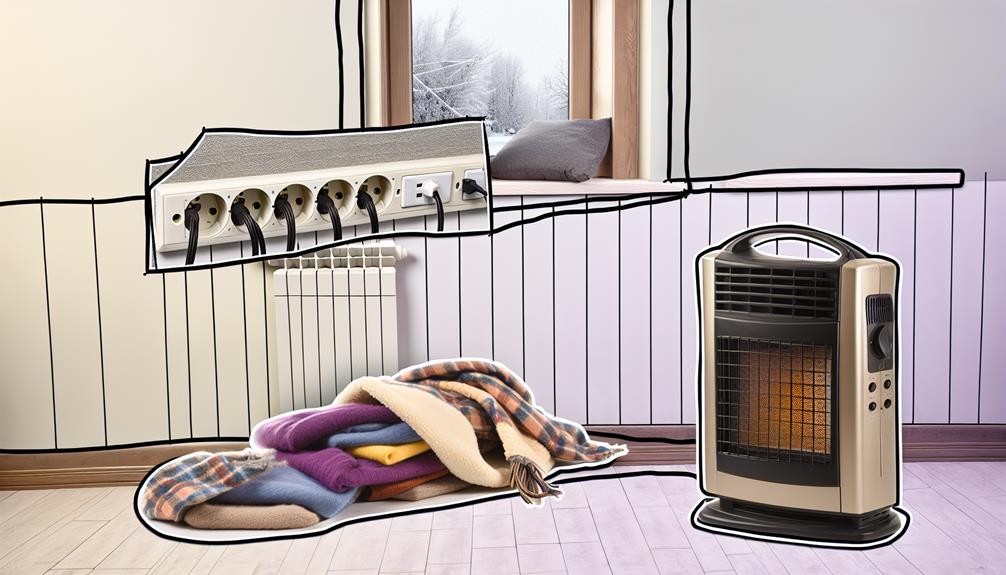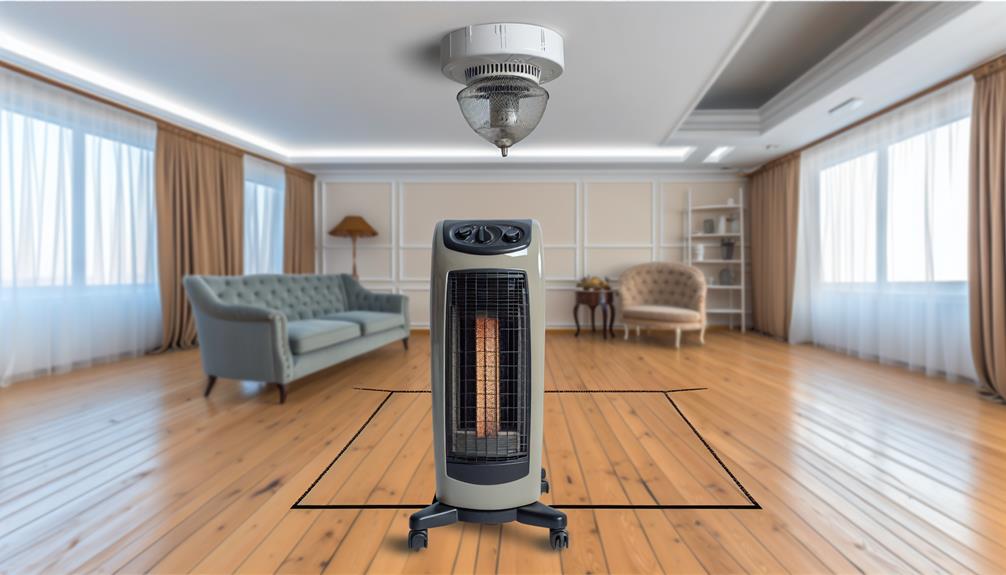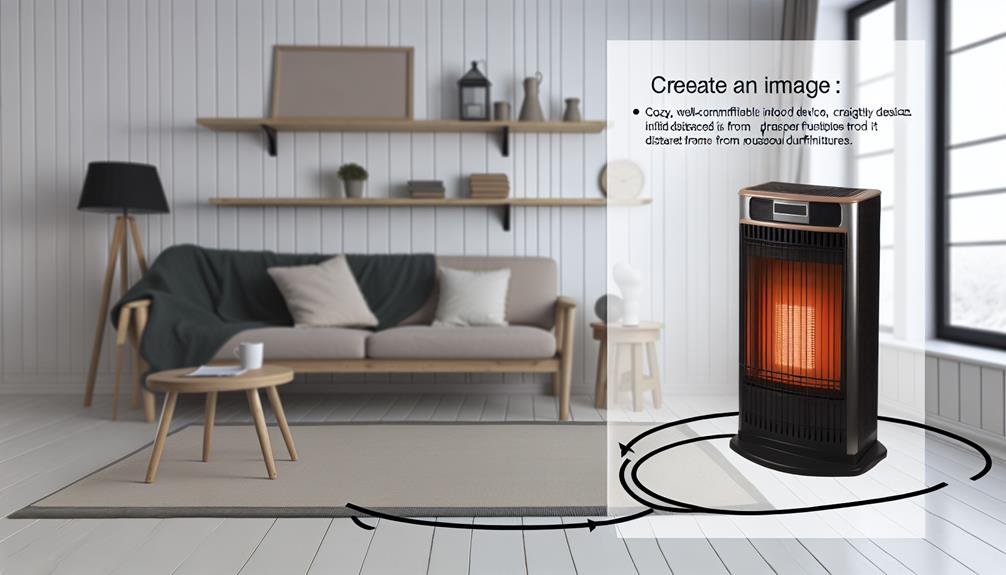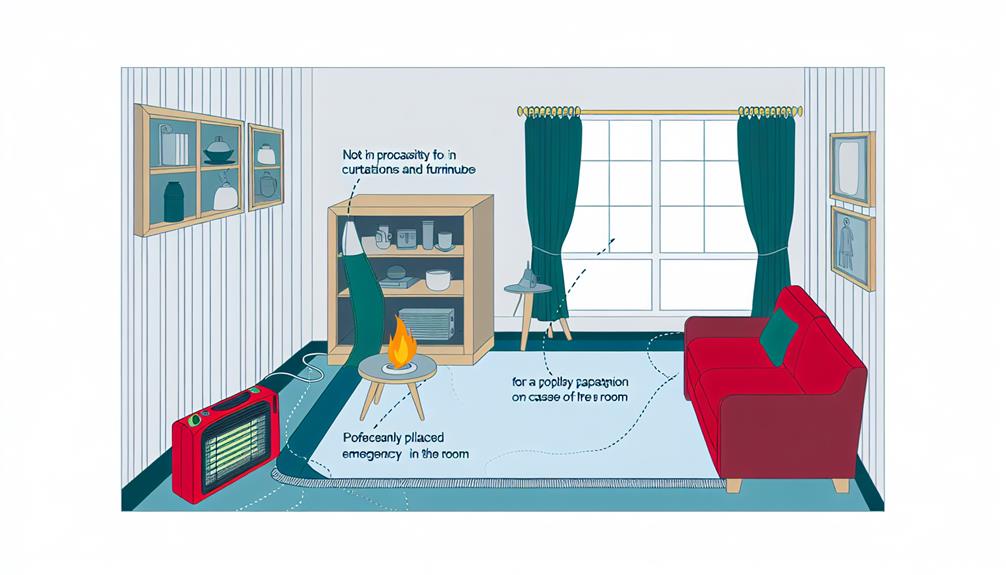Just as the cold season sneaks up on you, it's the same with the risks associated with portable heaters; they're often overlooked until a mishap occurs. You're aware that these devices are convenient sources of warmth, but it's crucial to recognize that they also come with significant fire hazards if not used correctly. As you strive to keep your space cozy, it's important to balance comfort with caution. From choosing the right heater to understanding the intricacies of safe operation, there are essential measures you need to employ to ensure your safety and that of those around you. The right information can transform your approach to using portable heaters, mitigating the risks and giving you peace of mind during the chillier months. Stick with us, and we'll explore the crucial steps that will keep you warm without sparking unwelcome surprises.
Key Takeaways
- Maintain a safety perimeter of at least three feet around the heater to prevent fire hazards.
- Check for recalls on your heater model to address potential fire risks.
- Choose a heater with safety features like automatic shut-off and tip-over protection.
- Ensure proper placement and ventilation to prevent fumes accumulation and overheating.
Understanding Portable Heater Risks

While portable heaters can provide convenient warmth, it's crucial to recognize the risks they pose, such as fire hazards, carbon monoxide poisoning, and electric shock. These risks are not merely theoretical; heater recalls happen with unsettling regularity due to manufacturing defects or design oversights that could turn a cozy evening into a dangerous situation.
Firstly, let's talk about fire hazards. Portable heaters are a leading cause of home fires during the colder months. They often occur when heaters are placed too close to combustible materials like curtains, bedding, or furniture. It's vital to maintain a safety perimeter of at least three feet around the heater and to never leave it unattended while in use. Remember to check for any recalls on your model, as manufacturers sometimes discover flaws that could pose a fire risk after the product has hit the market.
Carbon monoxide risks are another serious concern. This colorless, odorless gas can be deadly if emitted in high concentrations. Although electric heaters do not produce carbon monoxide, those that burn fuel like propane or kerosene can. It's imperative to ensure that your space is well-ventilated when using these types of heaters and to install carbon monoxide detectors as a precaution.
Choosing the Right Heater
Selecting the appropriate portable heater requires careful consideration of safety features, energy efficiency, and the specific heating needs of your space. Heater efficiency is crucial not only for reducing energy consumption but also for maintaining a comfortable and safe environment. When you're in the market for a new portable heater, it's important to choose one that suits the size of the area you need to heat, and that includes safety mechanisms like automatic shut-off and tip-over protection.
To help you compare, here's a table with key features to consider:
| Feature | Importance | Safety Tip |
|---|---|---|
| Automatic Shut-off | High | Prevents overheating |
| Tip-over Protection | Essential | Shuts off if knocked over |
| Thermostat Control | Beneficial | Maintains consistent temperature, conserving energy |
| Energy-Efficient Label | Sought-after | Indicates lower energy consumption |
An energy-efficient heater can significantly reduce your power bills and decrease the environmental impact. Be sure to look for models with an Energy Star rating or similar certifications that vouch for their heater efficiency.
Beyond energy consumption and safety features, consider the type of heater. Convection heaters are great for heating entire rooms, while radiant heaters are better for spot heating. Also, pay attention to the wattage—a higher wattage generally means more heat output, but also higher energy use. It's about finding the right balance for your needs.
Proper Placement Guidelines

Ensuring your portable heater's efficacy and safety starts with its proper placement in your home or workspace. When you're setting up your heater, it's crucial to consider heater stability to prevent any accidental tip-overs that could lead to fires. Always place your heater on a flat, level surface, away from foot traffic. Avoid putting it on top of furniture where it's not designed to sit, as this can compromise its stability.
Moreover, keep the heater at least three feet away from any combustible materials, such as curtains, bedding, furniture, or clothing. This clearance helps prevent these items from catching fire should they come into contact with the heater. Also, ensure that the heater isn't placed under a desk or in a confined space where heat can build up and potentially cause a fire hazard.
Ventilation requirements are another critical aspect of portable heater placement. Your heater needs to have enough air circulation to operate safely. Do not use it in an enclosed space where fumes can accumulate, especially if the heater is fuel-powered. Electric heaters also need good ventilation to prevent overheating.
Additionally, don't place the heater in damp or wet areas, such as bathrooms or kitchens, unless it's specifically designed for such environments. The presence of moisture can cause electrical components to short out and create a fire risk.
Remember to keep children and pets away from the heater to avoid burns or accidents. It's also a good idea to check the heater regularly for any signs of damage or malfunction. Following these guidelines will ensure that your portable heater warms your space efficiently and, more importantly, safely.
Regular Maintenance Checks
Beyond adhering to proper placement guidelines, it's essential to perform regular maintenance checks on your portable heater to safeguard its functionality and longevity. You're responsible for ensuring that every aspect of your heater is operating correctly, which not only keeps you warm during the colder months but also minimizes the risk of fire hazards.
Maintenance checks should be thorough and, if possible, in line with the manufacturer's recommendations. Here's what you should focus on:
- Component Inspection
- *Electrical Cords*: Check for fraying or damage. A compromised cord can be a fire risk.
- *Heating Elements*: Look for signs of wear or corrosion.
- *Thermostat*: Ensure it's accurately gauging and regulating temperature.
- Cleaning
- *Exterior*: Wipe down the heater's body to prevent dust accumulation that could impede airflow.
- *Interior Components*: Depending on the heater model, vacuum or gently clean the interior parts to avoid dust and lint buildup which can be a fire risk.
- Warranty Validation
- *Documentation*: Keep your purchase receipt and warranty information in a safe place.
- *Servicing*: If your heater needs repair, use an authorized service provider to maintain warranty validity.
- *Record Keeping*: Note the dates of your maintenance checks as part of your warranty upkeep.
Safe Operating Practices

When operating a portable heater, it's critical to adhere to certain practices to prevent accidents and maintain a safe environment. It's not just about turning the device on and off; you must be vigilant about how and where you use it to minimize the risk of fire or carbon monoxide poisoning.
Firstly, always ensure the heater is placed on a stable, flat surface, away from foot traffic and flammable materials like curtains, bedding, or furniture. Keep a clearance of at least three feet around the heater to prevent objects from coming into contact with it and potentially igniting.
Heater timers are an invaluable tool for safe operation. They allow you to control when the heater turns on and off, reducing the risk of it running unattended for extended periods. It's wise to use these timers to shut off the heater when you're asleep or away from home. Never leave a portable heater running unattended or while you're sleeping, as you won't be able to react quickly if an issue arises.
Ventilation requirements are also crucial. Portable heaters can produce carbon monoxide, a colorless, odorless gas that can be lethal in enclosed spaces. Ensure the room is adequately ventilated, especially if you're using gas or oil-burning heaters. Even electric heaters can cause oxygen levels to drop in tightly sealed rooms, so it's important to keep a window cracked open or have an air exchange system in place.
Features for Enhanced Safety
To bolster safety, modern portable heaters are often equipped with features like automatic shutoff sensors and tip-over protection mechanisms. These advancements are crucial in minimizing the risk of fires and ensuring that heater recalls due to safety concerns are less frequent. Manufacturers are continually innovating to provide you with safer heating options that integrate sophisticated technology for your peace of mind.
- Automatic Shutoff Sensors
- *Overheat Protection*: This feature detects when the heater's internal components reach unsafe temperatures and shuts down the unit to prevent overheating.
- *Carbon Monoxide Detectors*: Some models come with built-in sensors that alert you if dangerous levels of carbon monoxide are present, prompting immediate shutoff.
- Tip-Over Protection Mechanisms
- *Gravity Switches*: These switches automatically cut power if the heater is knocked over, reducing the risk of fire if the heater comes into contact with flammable materials.
- Thermostat Accuracy
- *Digital Thermostats*: Offer precise temperature control, ensuring the heater operates efficiently and safely.
- *Calibration*: Properly calibrated thermostats maintain the desired temperature without the risk of overheating.
The importance of thermostat accuracy cannot be overstated. It's essential for maintaining a comfortable environment as well as for safety. An accurate thermostat means your heater will cycle on and off as intended, reducing the risk of overheating and potential fires. Moreover, consistent thermostat performance can prevent the need for heater recalls, sparing you from the inconvenience and potential danger of using a faulty device.
Emergency Preparedness Tips

You must always be ready for unexpected situations when using portable heaters, starting with a clear escape plan in case of a fire. It's crucial to maintain at least a three-foot clearance around your heater, ensuring it's away from furniture, curtains, and other flammable materials. Regular checks of your smoke alarms can also safeguard your home by providing early warning signals during emergencies.
Create Escape Plans
Ensuring your family's safety begins with crafting a clear and concise escape plan in case a fire breaks out due to a portable heater mishap. Regular fire drills are essential in ingraining the escape routes and actions into everyone's memory. Here's what you need to do:
- Map out primary and secondary escape routes from each room
- Ensure windows aren't stuck, screens can be removed quickly
- Identify any obstacles and remove or find ways around them
- Conduct fire drills at different times
- Practice during the day and at night
- Simulate conditions like smoke or power outages
- Assign responsibilities
- Determine who will help children or the elderly
- Establish a meeting point outside the home
Maintain Heater Clearance
Maintaining a safe perimeter around your portable heater, at least three feet from all combustible materials, is a vital step in preventing fires and ensuring emergency preparedness. Different heater types emit varying levels of heat, so it's crucial to understand your specific model's requirements. Always consult the manufacturer's guidelines for clearance distances. The importance of ventilation can't be overstated; proper airflow is necessary to avoid overheating and potential ignition of nearby items. Additionally, never place clothing, drapes, or furniture near the heater, as these can easily catch fire. Be vigilant about keeping the area around your heater clear, both for efficient operation and to minimize the risk of fire. This simple practice is a cornerstone of heater safety.
Educating Household Members
Educating every member of your household about portable heater safety is crucial to preventing accidents and ensuring the wellbeing of all occupants. It's not enough to simply have safety measures in place; you need to make sure everyone understands and follows them consistently. Start by going over the heater instructions and providing usage reminders to all household members. Here are some key points to cover:
- Heater Instructions
- *Read and Share*: Ensure everyone has read the manual. Keep it accessible for quick reference.
- *Operating Procedures*: Demonstrate how to properly operate the heater, highlighting the on/off switch and thermostat settings.
- Usage Reminders
- *Timers and Supervision*: Remind everyone never to leave the heater unattended and to use timers if available.
- *Safety Checks*: Regularly check that the heater is in good working condition and not showing signs of damage.
- Emergency Protocols
- *Immediate Actions*: Teach what to do in case the heater malfunctions or if there's a fire—knowing how to use a fire extinguisher is key.
- Turn off the heater and unplug it.
- Call emergency services if necessary.
- *Evacuation Plan*: Make sure there's a clear and practiced evacuation plan in case of a fire.
Frequently Asked Questions
How Does the Altitude or Climate of an Area Affect the Use of Portable Heaters and Associated Fire Risks?
You should be aware that altitude and climate significantly impact portable heater use. Altitude adjustments are necessary since air density decreases with height, affecting combustion and heater efficiency. In humid climates, heaters work harder to achieve warmth, increasing fire risks. It's crucial to adapt your heater usage to these conditions to maintain safety and optimal performance. Always consult the manufacturer's guidelines for specific altitude and humidity considerations.
Can Portable Heaters Be Safely Used on Carpeted or Wooden Floors if Specific Safety Measures Are Taken?
Imagine your portable heater as a rebellious teen; it needs boundaries. Yes, you can safely use it on carpet or wood, but you've gotta lay down the law with floor clearance and heater stability. Ensure there's space beneath, like a moat around a castle, and it's as stable as a knight in armor. That's how you rule your domestic kingdom without fiery surprises. Always follow manufacturer guidelines for a safe realm!
Are There Differences in Fire Risk Between Using a Portable Heater in a Residential Home Versus a Commercial Setting?
Yes, there's a difference in fire risk when you use a portable heater in a residential versus a commercial setting. In commercial spaces, heater maintenance is often stricter and space clearance around the heater is usually larger, which reduces fire hazards. You'll need to ensure regular maintenance and keep ample space around your heater at home to match these safety standards and minimize your fire risk.
What Should I Do With My Portable Heater if I Am Going Away for an Extended Period, Like a Vacation or Business Trip?
If you're heading out for a while, remember that 25% of home heating fires are caused by portable heaters. To minimize risks, ensure your heater maintenance is up to date. Use timer functions to switch it off automatically, and ideally, unplug it before you leave. You'll reduce potential hazards and promote safety in your absence. It's the smart move to protect your space and enjoy peace of mind while you're away.
How Do Insurance Policies Typically Handle Incidents Involving Portable Heaters, and What Steps Can I Take to Ensure Coverage?
You'll find that insurance policies often have exclusions, especially for incidents caused by negligence. To ensure coverage for your portable heater, scrutinize your policy for any exclusions and consider policy upgrades for comprehensive protection. Always follow safety guidelines to avoid breaches in your policy. Document your heater's usage, maintenance, and storage, as insurers may require proof of responsible ownership in the event of a claim.
